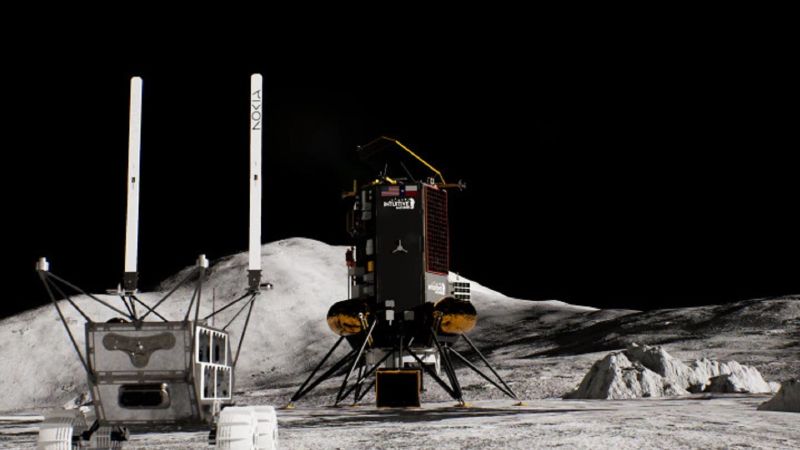Intuitive Machines/Nokia Bell Labs
An artist rendering of the Lunar Outpost rover, with Nokia antennas extended, on the Moon, a vision of Nokia and NASA’s mission to put a 4G cellular network on the lunar surface.
CNN
—
Texting on the Moon? Streaming on Mars? It may not be as far away as you think.
That’s the shared vision of NASA and Nokia, who have partnered to set up a cellular network on the Moon to help lay the building blocks for long-term human presence on other planets.
A SpaceX rocket is due to launch this year — the exact date has yet to be confirmed — carrying a simple 4G network to the Moon. The lander will install the system at the Moon’s south pole and then it will be remotely controlled from Earth.
“The first challenge to getting a network up and running is having a space-qualified cellular equipment that meets the appropriate size, weight, and power requirements, as well as being deployed without a technician,” Walt Engelund, deputy associate administrator for programs at NASA’s Space Technology Mission Directorate, told CNN. No less of a challenge, it will need to operate in the harsh lunar environment of extreme temperatures and radiation.
The 4G network unit is being built by Nokia’s Bell Labs using a range of off-the-shelf commercial components. It will be loaded onto a lander made by US company Intuitive Machines, and once deployed it will connect the lander via radio equipment to two roaming vehicles with their own special mission: to search for ice.
Intuitive Machines/Nokia Bell Labs
An artist rendering of the lander making its descent to the surface.
One of the vehicles, the Lunar Outpost rover, will explore the area known as Shackleton Connecting Ridge, while the other, the Micro-Nova hopper, will plunge into a crater to scan for unprecedented up-close evidence of Moon ice.
Images of ice — transmitted back to the lander and then Earth in near real-time via the cellular network — would be a world-first. Lunar ice could be used to create breathable oxygen, and even fuel that could eventually be used to launch Mars missions from the Moon.
For NASA’s Artemis program, which aims to return astronauts to the moon this decade, cellular connectivity is invaluable.
Currently, astronauts talk to each other by radio, but NASA wants a lunar communications system capable of supporting high-resolution video and science data, said Engelund — especially as Artemis missions become more sophisticated.
“Being able to communicate on the Moon is critical to Artemis — as critical as any other mission element like power, water to drink, and air to breathe,” said Engelund.
“Eventually, this effort will help establish a lunar communications network that could give our explorers the ability to beam scientific data back, confer with mission control, and talk to their families, as if they were walking down the street on their cellphones.”
It could lay the groundwork for an off-world internet not dissimilar to that of Earth’s. Personal devices could connect to such networks, allowing space colonists to use smartphones that can access all the apps and services available to those back on Earth.
NASA selected Bell Labs as part of its Tipping Point initiative, a series of partnerships with companies to develop technologies for future missions that puts them in prime position for key roles in the future space economy.
Bell Labs was given a $14.1 million grant in 2020, and in January, Nokia was selected by the US Defense Advanced Research Projects Agency (DARPA) to begin working on a communications services infrastructure that will eventually serve as the “framework for the lunar economy.”
“A future lunar economy will critically depend on communication technologies to collect and analyze data, share information, and maintain and control operations,” Thierry Klein, president of Bell Labs Solutions Research, told CNN.
“This includes sustaining a semi-permanent or permanent human presence on the Moon, as well as automated robotic operations for transportation, resource mining, mineral processing and scientific data collection.”
Intuitive Machines/Nokia Bell Labs
An artist rendering showing a close-up view of the 4G base station unit integrated into the lander.
There are potential commercial benefits for Earthly business ventures too.
If a network can withstand the journey into orbit, then deploy and endure autonomously amid the vacuum of space, wildly fluctuating temperatures and cosmic radiation, it will be able to survive the harshest locations on Earth — such as polar ice caps, deserts, or offshore platforms.
“Especially when it comes to remote deployments, industrial sites, public safety, emergency response, disaster recovery or defense, it is highly beneficial to have compact, low-footprint network equipment that can be easily transported and deployed anywhere,” Klein said.
Courtesy of The National Aeronautics and Space Administration (NASA) photographic archives
Ethan Miller / Staff
TONY KARUMBA / Stringer
MIGUEL MEDINA/AFP/AFP via Getty Images
JOHN THYS / Stringer – AFP via Getty Images
Courtesy of The National Aeronautics and Space Administration (NASA) photographic archives
BERTRAND GUAY / Contributor
Courtesy of The National Aeronautics and Space Administration (NASA) photographic archives
Shutterstock
NASA
Katharine Lotze / Staff
Shutterstock

Dr. Thomas Hughes is a UK-based scientist and science communicator who makes complex topics accessible to readers. His articles explore breakthroughs in various scientific disciplines, from space exploration to cutting-edge research.








